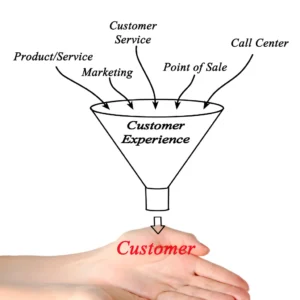
Unlocking Retail Excellence
AI Tools Transforming B2C Inventory & Supply Chain Management
Artificial Intelligence (AI) integration has become a game-changer in the ever-evolving retail landscape, particularly in Inventory and Supply Chain Management.
This article explores the comprehensive AI Tools for Inventory and Supply Chain Management, addressing the intricacies of demand forecasting, automated re-order systems, supplier analytics, route optimization, and inventory health monitoring.
While the potential benefits are immense, from cost savings to enhanced customer satisfaction, the journey is challenging.
We delve into the technical intricacies, training needs, and the delicate balance of costs and benefits of developing and utilizing these cutting-edge AI tools.
Join us on a journey where technology meets retail, shaping the future of efficient and responsive inventory management.
Table of Contents
AI Tool ideas for Inventory and Supply Chain Management
- AI-Powered Demand Forecasting:
- Utilize machine learning algorithms for accurate demand forecasting.
- The latest trends include a seamless integration of sales and inventory systems, allowing real-time data exchange.
- Design a scalable infrastructure to handle and process large datasets efficiently.
- Automated Re-order Systems:
- Develop predictive algorithms for determining re-order points based on historical data and demand forecasting.
- Integrate with supplier databases and ordering systems for streamlined procurement.
- Implement real-time monitoring of inventory levels to trigger automatic re-order processes.
- Set up configurable alerts for inventory thresholds.
- Supplier Performance Analytics:
- Utilize data analytics tools to assess supplier performance metrics.
- Establish seamless integration with supplier databases and procurement systems.
- Develop customizable dashboards for visualizing supplier performance.
- Include metrics such as delivery times, quality, and adherence to contracts.
- Route Optimization for Deliveries:
- Integrate with real-time traffic and weather data for dynamic route adjustments.
- Implement algorithms to optimize delivery routes based on cost, time, and other relevant factors.
- Develop a mobile application for drivers with real-time updates and route suggestions.
- Provide features for route deviation and rerouting in case of unforeseen circumstances.
- Inventory Health Monitoring:
- Develop algorithms to identify slow-moving items and potential stockouts.
- Integrate with promotions and marketing systems to align inventory with marketing strategies.
- Implement automated promotion suggestions for slow-moving items to stimulate sales.
- Generate reports and alerts for inventory health and performance.
Business Knowledge Requirements
Understanding Retail B2C Business:
Starting to develop AI-based Inventory and Supply Chain Management tools for the Retail B2C industry requires a deep understanding of the non-technical aspects of the business. Here’s an elaborate exploration of the critical knowledge requirements:
Market Dynamics and Customer Behavior:
One needs a profound understanding of the retail market dynamics to build practical tools. This includes recognizing the target audience, understanding consumer behaviours, and staying attuned to market trends. Knowing the preferences, shopping habits, and factors influencing purchasing decisions is crucial to tailor the AI tools to meet customer demands.
Product Life Cycles and Seasonal Trends:
Knowledge of product life cycles and seasonal trends is vital. Recognizing which products are in demand during specific seasons or events helps refine the demand forecasting algorithms. Understanding the cyclical nature of certain items enables the system to anticipate and manage inventory accordingly, preventing overstocking or stockouts.
Supplier Relationships and Negotiation:
Establishing strong supplier relationships is critical. Knowing how to negotiate favourable terms, assess supplier performance, and maintain a reliable supply chain is essential. Understanding the intricacies of procurement processes helps develop features that enhance supplier analytics and streamline the ordering process.
Marketing and Promotions:
An in-depth comprehension of marketing strategies and promotional activities is crucial. Integrating tools with promotional systems can strategically boost sales of slow-moving items. Aligning inventory management with marketing campaigns helps optimize stock levels based on promotional activities.
Regulatory Compliance and Ethical Considerations:
Being aware of industry regulations and ethical considerations is non-negotiable. Adhering to data privacy standards, ensuring compliance with legal requirements, and maintaining ethical practices are fundamental to gaining trust and avoiding legal complications.
Customer Service and Satisfaction:
Understanding the importance of customer satisfaction is paramount. The tools should optimize inventory and contribute to a positive customer experience. Real-time monitoring and adjustments should consider the impact on order fulfilment and delivery timelines to enhance customer satisfaction.
Continuous Improvement and Adaptability:
The tools should be designed with adaptability, allowing for continuous improvement based on feedback, market shifts, and emerging technologies. Staying abreast of industry advancements ensures the tools remain relevant and practical.
Technical Knowledge Requirements for Retail B2C Industry AI Tools
Programming Languages and Frameworks:
Expertise in Python, Java, or C++ is essential to develop AI algorithms, process data, and integrate systems. Familiarity with relevant frameworks like TensorFlow or PyTorch is crucial for building and deploying machine learning models.
Data Processing and Storage:
A solid understanding of data processing and storage is essential. Knowledge of databases, particularly relational databases (e.g., MySQL, PostgreSQL) and NoSQL databases (e.g., MongoDB), is crucial for efficiently managing and retrieving large volumes of inventory and supply chain data. Implementing scalable and optimized data processing solutions is imperative.
Machine Learning and Predictive Analytics:
Expertise in machine learning (ML) is at the core of AI-powered demand forecasting and automated re-order systems. Knowledge of ML algorithms, statistical modelling, and predictive analytics is necessary to develop accurate demand forecasting models, re-order algorithms, and supplier performance analytics tools. Proficiency in tools like Jupyter Notebooks facilitates model development and testing.
Cloud Computing Platforms:
A firm grasp of cloud computing platforms like AWS, Azure, or Google Cloud is indispensable. These platforms provide scalable infrastructure for handling large datasets, running AI algorithms, and deploying applications. Leveraging cloud services allows for flexibility, cost-effectiveness, and efficient scaling of the AI toolset.
Integration and APIs:
Understanding how to integrate with various systems and databases is crucial for seamless operation. Knowledge of API (Application Programming Interface) development and consumption is vital for integrating the toolset with sales systems, supplier databases, and other external platforms. This ensures real-time data exchange and synchronization.
Mobile Application Development:
Knowledge of mobile application development is necessary for route optimization and real-time updates. Proficiency in languages like Java or Kotlin for Android or Swift for iOS is essential. Utilizing frameworks like React Native or Flutter allows cross-platform development, ensuring a broader reach.
DevOps and Continuous Integration/Continuous Deployment (CI/CD):
A solid understanding of DevOps practices facilitates efficient development, testing, and deployment. Implementing CI/CD pipelines ensures a smooth and automated process for updating and releasing new features. Knowledge of tools like Jenkins or GitLab CI aids in automating the build, test, and deployment phases.
Geospatial Data and Mapping:
For route optimization, integrating geospatial data and mapping tools is necessary. Familiarity with tools like Google Maps API or Mapbox supports the development of algorithms with real-time weather and traffic conditions for optimizing delivery routes.
Cybersecurity:
Understanding cybersecurity principles is critical, given the sensitive nature of inventory and supply chain data. Knowledge of encryption techniques, secure data transmission, and secure coding practices helps safeguard the toolset against potential threats and vulnerabilities.
Current Technologies for Retail B2C Industry AI Tools
Cloud Computing Platforms:
Leading cloud providers like AWS, Microsoft Azure, and Google Cloud offer a comprehensive AI tool-development services suite. These platforms provide scalable computing resources, storage solutions, and machine learning services. AWS’s SageMaker, Azure’s Machine Learning Services, and Google Cloud AI Platform facilitate the development and deployment of machine learning models.
Machine Learning Frameworks:
Frameworks like TensorFlow and PyTorch are at the forefront of machine learning development. TensorFlow, an open-source library by Google, provides an ecosystem for building and deploying ML models. PyTorch, developed by Facebook, is known for its dynamic computational graph, making it suitable for research and development. These frameworks simplify the implementation of AI algorithms for demand forecasting and predictive analytics.
Data Analytics and Business Intelligence Tools:
Tools like Tableau, Power BI, and Looker offer potent data visualization and analytics capabilities. They are integrated into the AI toolset to create customizable dashboards for visualizing supplier performance metrics, inventory health, and other key performance indicators. They empower users to derive actionable insights from complex datasets.
Route Optimization APIs and Geospatial Tools:
Developers can utilize APIs from platforms like Google Maps, Mapbox, or HERE Technologies for efficient route optimization. These APIs provide real-time traffic data, geocoding, and mapping functionalities essential for optimizing delivery routes. Integrating these tools enhances the accuracy of route planning algorithms.
Mobile App Development Frameworks:
Frameworks like React Native and Flutter streamline the development of cross-platform mobile applications. These tools enable the creation of a mobile application for drivers, ensuring real-time updates, route suggestions, and seamless communication. React Native, developed by Facebook, and Flutter, by Google, offer efficient ways to build high-performance mobile applications.
Blockchain for Supply Chain Transparency:
Blockchain technology can improve transparency and traceability in the supply chain. Platforms like IBM Blockchain and Hyperledger provide solutions for secure and immutable record-keeping. Integrating blockchain into the AI toolset ensures a tamper-proof transaction record, enhancing supply chain trust.
Advanced Analytics Platforms:
SAS Analytics and IBM SPSS are advanced analytics platforms for in-depth statistical analysis and modelling. These tools contribute to developing sophisticated algorithms for demand forecasting, re-order point determination and inventory health monitoring.
Robotic Process Automation (RPA):
RPA tools like UiPath and Automation Anywhere can automate repetitive inventory and supply chain management tasks. These tools enhance efficiency by automating processes such as data entry, order processing, and inventory monitoring, reducing the workload on human resources.
API Management Platforms:
API management platforms like Apigee and MuleSoft facilitate seamless integration with external systems, databases, and supplier networks. These platforms ensure efficient communication between the AI toolset and various data sources, allowing real-time updates and synchronization.
Technical Integrations for Retail B2C Industry AI Tools
Sales and Inventory Systems Integration:
Integrating the AI tools with existing sales and inventory systems is crucial for real-time data exchange. API endpoints should be established to facilitate the flow of information, ensuring that inventory levels, sales data, and order processing are synchronized. This integration automates the re-order processes and optimizes demand forecasting accuracy based on current sales trends.
Supplier Databases and Ordering Systems:
Integration with supplier databases and ordering systems is necessary to enhance supplier relationship management. APIs or direct connections should quickly fetch supplier information, track deliveries, and place orders. This integration ensures that the AI tools have up-to-date information for supplier performance analytics and automated re-order systems.
Promotions and Marketing Systems:
Aligning the AI toolset with promotions and marketing systems is essential for effective inventory health monitoring. Integration with marketing databases and systems allows the tools to adapt to promotional strategies. By understanding ongoing promotions, the system can make informed suggestions for slow-moving items, enhancing the effectiveness of marketing campaigns.
Real-Time Traffic and Weather Data:
Integration with real-time traffic and weather data sources is critical for route optimization in deliveries. APIs from platforms like Google Maps or dedicated weather services enable the AI tools to adjust delivery routes dynamically. This ensures drivers receive accurate and up-to-date information, optimizing delivery times and minimizing disruptions.
Procurement Systems:
Integrating with procurement systems streamlines the entire procurement process. This includes connecting with ERP systems, purchase order systems, and invoicing platforms. Seamless communication with procurement systems ensures that supplier performance analytics are accurate and that re-order processes align with the procurement workflow.
Mobile Application for Drivers:
Integration with the mobile application for drivers involves connecting the application with the central AI system. APIs should communicate real-time updates, route suggestions, and order information efficiently. This integration ensures that drivers have access to the latest information, enhancing their ability to optimize routes and manage deliveries effectively.
Data Analytics and Business Intelligence Platforms:
Connecting the AI toolset with data analytics and business intelligence platforms allows the creation of customizable dashboards. Integration with tools like Tableau or Power BI ensures stakeholders can visualize performance metrics, supplier analytics, and inventory health in a user-friendly interface, aiding decision-making processes.
API Management Platforms:
Utilizing API management platforms becomes crucial for maintaining a coherent integration strategy. Platforms like Apigee or MuleSoft provide the infrastructure to manage, monitor, and secure APIs. Effective API management ensures that integrations are reliable, scalable, and adhere to security standards.
Continuous Monitoring and Feedback Loops:
Integrating continuous monitoring tools and feedback loops is essential for improving the AI toolset. This involves connecting with monitoring systems that track performance, identify potential issues, and collect user feedback. Continuous integration and deployment pipelines should also be in place to implement updates and improvements based on real-world usage and feedback.
Training Needs for Staff Managing AI-based Inventory and Supply Chain Management Tools
Understanding of AI Concepts and Terminology:
Staff members need to grasp fundamental concepts and terminology related to artificial intelligence. Training sessions should cover machine learning, predictive analytics, algorithms, and data processing. This foundational knowledge helps staff understand how the AI tools operate and make informed decisions based on generated insights.
System Navigation and Interface Familiarization:
Training should include hands-on sessions to familiarize staff with the user interface and navigation of the AI tools. Staff members should learn to access different features, generate reports, and interpret dashboard metrics. Practical exercises and simulations can help build confidence in using the tools effectively.
Data Input and Management:
Understanding data input requirements and management processes is essential. Staff should be trained to input and update data accurately, ensuring the integrity of the system’s database. Training sessions should cover data validation, cleansing techniques, and best practices for maintaining data quality over time.
Interpreting and Acting on Insights:
Staff training should analyze demand forecasts, supplier performance metrics, inventory health indicators, and route optimization suggestions. Staff should learn to make data-driven decisions and implement strategies to optimize inventory and supply chain operations.
Integration and System Interaction:
Training should address how the AI-based tools integrate with existing systems and platforms. Staff members should understand the flow of data between different systems, how to troubleshoot integration issues, and ensure data synchronization. This knowledge enables staff to manage the end-to-end inventory and supply chain processes effectively.
Supplier Relationship Management:
For staff involved in procurement and supplier management, training should focus on utilizing AI tools to enhance supplier relationships. This includes understanding supplier performance analytics, interpreting supplier metrics, and leveraging insights to negotiate favourable terms. Staff should also be trained to communicate with suppliers regarding orders, deliveries, and performance feedback.
Route Optimization and Delivery Management:
For staff responsible for logistics and delivery management, training should cover route optimization techniques and utilizing real-time traffic and weather data. Staff members should learn how to interpret route suggestions generated by the AI tools, adjust delivery schedules based on traffic conditions, and optimize delivery routes for efficiency and cost-effectiveness.
Security and Compliance Training:
Given the sensitive nature of inventory and supply chain data, staff should receive training on cybersecurity best practices and compliance requirements. This includes understanding data privacy regulations, securing access to the AI tools, and implementing measures to protect against data breaches and unauthorized access.
Continuous Learning and Updates:
Training should not be a one-time event but an ongoing process. Staff members should be encouraged to continuously learn to stay updated on new features, enhancements, and best practices related to AI tools. Regular training sessions, workshops, and access to educational resources ensure that staff can maximize the value of the AI tools over time.

Arindam Roy
An Automation Consultant with 25+ years of IT Experience
Challenges and Workarounds in Developing and Utilizing Retail B2C Industry AI Tools:
Data Quality and Integration Challenges
Challenge:
Only complete or accurate data can help the effectiveness of AI algorithms. Integrating data from disparate sources may also pose challenges, leading to consistency.
Workaround:
- Implement robust data governance practices to ensure data quality.
- Regularly validate and clean the data.
- Employ data integration tools and establish clear data standards to facilitate seamless integration between different systems.
User Adoption and Training
Challenge:
To adopt new AI tools, staff may need more understanding and fear of job displacement. Training staff adequately can be time-consuming.
Workaround:
- Develop comprehensive training programs that emphasize the benefits of AI tools and address concerns.
- Provide ongoing support, create user-friendly interfaces, and encourage a positive mindset towards technology adoption.
- Showcase success stories to demonstrate tangible benefits.
Security and Compliance Concerns
Challenge:
Handling sensitive inventory and supply chain data raises security and compliance concerns. Data breaches or non-compliance can have severe consequences.
Workaround:
- Implement robust cybersecurity measures, including encryption and secure access controls.
- Stay informed about and adhere to data privacy regulations.
Algorithm Accuracy and Predictive Modeling
Challenge:
Achieving high demand forecasting and predictive modelling accuracy can be challenging due to evolving market dynamics and unforeseen external factors.
Workaround:
- Continuously refine and update algorithms based on real-world feedback and market changes.
- Utilize machine learning techniques that allow models to adapt to new data patterns.
- Implement a feedback loop to gather user information and adjust the algorithms accordingly.
Supplier Collaboration and Integration
Challenge:
Collaborating with suppliers and integrating their systems are complex, especially when dealing with diverse suppliers using different technologies.
Workaround:
- Standardize communication protocols and data formats to facilitate seamless integration.
- Establish clear communication channels with suppliers, providing support for system integration.
- Use intermediary platforms or API management tools to bridge technology gaps.
Mobile Application Performance
Challenge:
Ensuring the smooth performance of the mobile application for drivers, especially in areas with poor network connectivity, can be challenging.
Workaround:
- Develop offline capabilities within the mobile application to handle situations with limited connectivity.
- Optimize the application for performance and conduct thorough testing under various network conditions.
- Provide training for drivers to troubleshoot common issues.
Cost and Resource Allocation
Challenge:
Implementing AI tools may require significant upfront costs, and ongoing maintenance and support can strain resources.
Workaround:
- Consider phased implementation to manage costs.
- Explore cloud-based solutions to reduce infrastructure costs and leverage managed services.
- Monitor and optimize resource usage to ensure efficiency.
Regulatory Changes and Adaptability
Challenge:
Rapid changes in regulations affecting the retail industry may require frequent adjustments to the AI tools.
Workaround:
- Stay informed about regulatory changes and design the system with flexibility in mind.
- Implement modular architectures and scalable infrastructure to adapt to evolving regulatory requirements quickly.
- Engage legal experts to provide insights on compliance.
Cost and Benefits of Retail B2C Industry AI-based Inventory and Supply Chain Management Tools:
Upfront Costs:
- Development and Integration: The initial investment includes costs for developing and integrating AI tools with existing systems. This encompasses expenses for skilled developers, data scientists, and integration specialists.
- Infrastructure and Cloud Services: Setting up the necessary infrastructure and utilizing cloud services contribute to upfront costs. Costs may vary based on the chosen cloud provider, computational requirements, and storage needs.
- Training and Onboarding: Training staff to use and manage the AI tools incurs upfront costs. This includes developing training materials, conducting sessions, and providing ongoing support during the onboarding process.
- Security Measures: Implementing robust cybersecurity measures to safeguard sensitive data adds to initial costs. This includes investments in encryption technologies, secure access controls, and regular security audits.
Ongoing Operational Costs:
- Maintenance and Updates: Continuous maintenance and updates are necessary to keep the AI tools operating efficiently. This includes bug fixes, performance optimizations, and algorithm updates based on feedback and market changes.
- Cloud Service Fees: Ongoing operational costs include fees for utilizing cloud services. Depending on the usage patterns, costs may fluctuate, and effective management is crucial for cost control.
- Staff Training and Support: Continuous training and support for staff to adapt to new features and address challenges contribute to ongoing operational costs. This ensures that the workforce remains proficient in utilizing the AI tools effectively.
- Monitoring and Analytics: Implementing tools for monitoring system performance and analyzing user analytics incurs ongoing costs. This is essential for identifying areas of improvement, optimizing algorithms, and ensuring the tools align with business goals.
Benefits:
- Efficiency Gains: AI-based tools streamline inventory and supply chain processes, reducing manual efforts and improving overall operational efficiency. Automating demand forecasting, re-order processes, and route optimization enhances productivity.
- Cost Savings: Managing your inventory can help reduce your carrying costs and minimize the risk of overstocking or stockouts. This means you can save money and ensure you always have the right stock to meet demand. AI tools optimize procurement, helping negotiate favourable terms with suppliers and contributing to cost savings over time.
- Improved Decision-Making: Access to real-time insights and analytics empowers decision-makers. Retailers can make data-driven decisions based on accurate demand forecasts, supplier performance metrics, and inventory health indicators, leading to improved decision-making.
- Enhanced Customer Satisfaction: Efficient inventory and supply chain management result in timely deliveries and better product availability. This positively impacts customer satisfaction and loyalty, increasing sales and revenue.
- Competitive Advantage: Utilizing AI-powered tools can give businesses a competitive advantage in the ever-changing retail industry. Advanced technologies enable retailers to adapt to market changes and stay ahead of competitors while meeting consumer preferences.
- Adaptability to Market Changes: The flexibility of AI tools allows retailers to adapt to changing market dynamics, regulatory requirements, and industry trends. The adaptability ensures that the tools remain relevant and effective over the long term.
Conclusion
In conclusion, the journey towards implementing Retail B2C Industry AI-based Inventory and Supply Chain Management tools is a strategic investment that offers a transformative impact on operational efficiency and competitiveness. The challenges, such as data quality, user adoption, security concerns, and algorithm accuracy, are formidable but navigable with the right strategies and workarounds.
The upfront costs, encompassing development, integration, training, and security measures, may seem significant, but they pave the way for long-term benefits. These benefits include efficiency gains through automation, cost savings from optimized inventory management, improved decision-making fueled by real-time insights, enhanced customer satisfaction through reliable deliveries, and a sustainable competitive advantage in the dynamic retail landscape.
Continuous adaptation to market changes, facilitated by the adaptability of AI tools, ensures their relevance over time. These tools ‘ sustained advantages and continual optimization justify the ongoing operational costs, including maintenance, cloud services, staff training, and analytics.
The staff training needs are met through comprehensive programs that enhance technical proficiency and foster a positive mindset towards technology adoption. Overcoming challenges like user resistance, data quality issues, and security concerns becomes a collaborative effort where staff and management contribute to the AI implementation’s success.
In essence, the Retail B2C Industry AI-based Inventory and Supply Chain Management tools represent a paradigm shift towards a data-driven, efficient, and customer-centric approach to retail. As businesses navigate the complexities of integration, staff training, and ongoing adaptation, the promise of improved operational excellence, cost-effectiveness, and a stronger competitive position positions these tools as indispensable assets for the future of retail. The marriage of technology and retail management not only streamlines day-to-day operations but also shapes a resilient and responsive retail ecosystem ready to meet the evolving demands of the modern market.
Related Articles
- AI Automation Tools in Brick-and-Mortar Retail Store
- AI Tools for Retail B2C Industry
- AI Tools for Customer Feedback and Support in Retail B2C
- AI Tools for Marketing and Advertising in Retail B2C Industry
- AI Tools for Fraud Prevention and Security in Retail B2C
- AI Tools for Sales and Conversion Optimization in the Retail B2C
- AI Tools for Customer Loyalty and Retention in Retail B2C
- AI Tools for Analytics and Reporting in Retail B2C Industry
- AI Tools for Product Management and Innovation in Retail
- AI Tools for Supply Chain Visibility and Optimization in Retail
- AI Tools for Customer Experience and Engagement in Retail
- AI in Retail Customer Experience
























